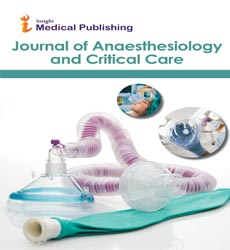Introduction of Anaesthesia.
Mark Walsh*
Department of Anesthesiology, University of California, USA
- *Corresponding Author:
- Mark Walsh
Department of Anesthesiology, University of California, USA
E-mail: markwalsh@gmail.com
Received Date: September 13, 2021; Accepted Date: September 17, 2021; Published Date: September 22, 2021
Citation: Walsh M (2021) Introduction of Anaesthesia. J Anaesthesiol Crit Car. Vol.4 No.1:01
Editorial
Anaesthesia is the induction of a controlled, brief loss of sensation or awareness for medical reasons. It can include any or all of the following: analgesia (pain reduction or avoidance), paralysis (muscle relaxation), amnesia (memory loss), and unconsciousness. Anesthetized refers to a patient who is under the influence of anaesthetic medications. Using either injected or inhaled medicines, general anaesthesia slows central nervous system activity, resulting in unconsciousness and total loss of sensation. Sedation suppresses the central nervous system to a lower extent, limiting anxiety as well as the formation of long-term memories without making the person unconscious. Anaesthesia that stops nerve impulses from a specific section of the body is known as regional and local anaesthesia. This can be used alone (in which case the patient remains completely conscious) or in combination with general anaesthesia or sedation, depending on the situation. Peripheral nerves can be targeted with drugs to anaesthetize a specific region of the body, such as numbing a tooth for dental work or using a nerve block to block sensation in an entire limb. Alternatively, epidural and spinal anaesthesia can be administered directly to the central nervous system, thereby blocking all incoming feeling from nerves supplying the blocked location.
Varied types of anaesthesia have different effects on the endpoints. Analgesia is affected by regional anaesthesia; amnesia is favoured by benzodiazepine-type sedatives (used for sedation, or "twilight anaesthesia"); and general anaesthetics can impact all of the goals. The purpose of anaesthesia is to achieve the required endpoints for a surgical procedure while posing the least amount of danger to the patient. Drugs act on separate but interrelated elements of the neurological system to achieve anaesthesia's goals. Hypnosis, for example, is produced by acts on the brain's nuclei and is analogous to the activation of sleep. People become less conscious of and less reactive to harmful stimuli as a result of this impact. The impact of medicines on various (but particular) regions of the brain causes memory loss (amnesia). Memories are formed as declarative or non-declarative memories over time (short-term, long-term, long-lasting), the strength of which is determined by synaptic plasticity (the strength of connections between neurons).
Anaesthesia is unique in that it does not provide direct treatment; rather, it permits others to perform tasks that may help treat, diagnose, or cure a condition that would otherwise be painful or difficult. As a result, the ideal anaesthetic is the one that poses the least risk to the patient while still achieving the procedure's targets. The pre-operative risk assessment, which includes a medical history, physical examination, and lab testing, is the first step in anaesthesia. The doctor can reduce anaesthetic risks by diagnosing a patient's pre-operative physical status. The ability of well-functioning teams of highly trained healthcare workers to provide safe anaesthetic care is critical. Anaesthesiology is the medical speciality that focuses on anaesthesia, and anesthesiologists are doctors who specialise in the discipline. Anesthesia nurses, nurse anaesthetists, anaesthesiologist assistants, anaesthetic technicians, anaesthesia associates, operating department practitioners, and anaesthesia technologists are ancillary healthcare personnel that provide anaesthesia. Their names and tasks vary depending on the jurisdiction.
Anaesthesia is the result of medications working on different but overlapping locations in the central nervous system to achieve the above-mentioned outcomes. The three major goals of general anaesthesia (as opposed to sedation or regional anaesthesia) are paralysis, unconsciousness, and a blunting of the stress reaction. Anaesthetics could dependably achieve the first two in the early days of anaesthesia, allowing surgeons to do critical surgeries, but many patients perished as a result of the surgical insult's extremes in blood pressure and pulse, which were ultimately damaging.
Open Access Journals
- Aquaculture & Veterinary Science
- Chemistry & Chemical Sciences
- Clinical Sciences
- Engineering
- General Science
- Genetics & Molecular Biology
- Health Care & Nursing
- Immunology & Microbiology
- Materials Science
- Mathematics & Physics
- Medical Sciences
- Neurology & Psychiatry
- Oncology & Cancer Science
- Pharmaceutical Sciences
